Two days before he was scheduled to die, John Shields roused in his hospice bed with an unusual idea. He wanted to organize an Irish wake for himself. It would be old-fashioned with music and booze, except for one notable detail - he would be present.
The party should take up a big section of Swiss Chalet, a family-style chain restaurant on the road out of town. Shields wanted his last supper to be one he so often enjoyed on Friday nights when he was a young Catholic priest - rotisserie chicken legs with gravy.
Then, his family would take him home and he would die there in the morning, preferably in the garden. It was his favorite spot, rocky and wild. Flowering native shrubs pressed in from all sides, and a stone Buddha and birdbath peeked out from among the ferns and boulders. Before he got sick, Shields liked to sit in his old Adirondack chair and watch the bald eagles train their juveniles to soar overhead. He meditated there twice a day, among the towering Douglas firs.
“Someone once asked me how did I get to become unique,” he said that afternoon in his hospice bed. “I recommend meditation as a starting place - bringing your consciousness to bear.” Shields intended to die swiftly and peacefully by lethal injection, administered by his doctor. In June, the Canadian government legalized what it termed “medical assistance in dying” for competent adult patients who are near death and suffering intolerably from irremediable illnesses. When his doctor, Stefanie Green, informed him that he qualified, Shields felt the first hope since a doctor told him more than a year before that he had a rare and incurable disease called amyloidosis, which caused proteins to build up in his heart and painfully damage the nerves in his arms and legs.
Having control over the terms of his death made him feel empowered over the disease rather than crippled by it, a common response among Green’s patients. Shields believed that dying openly and without fear could be his most meaningful legacy - which was saying something. The man had packed five lifetimes of service into one: he had been a civil rights activist, a social worker for children, the head of British Columbia’s biggest union and, most recently, the savior of a floundering land trust that included 7,191 acres of protected wilderness and historic properties.
His newly developed plan for how he would spend his last moments, though, worried his wife, Robin June Hood. Her husband had not left his bed once since he arrived at the hospice on a stretcher, 17 days earlier. His 78-year-old body had thinned; his voice dimmed. He lasted only 15 minutes in conversation before his eyes fluttered closed. Just leaving the room would exhaust him. She knew he could not make it to the restaurant, and there was no way she could tend to his needs at home, even for one night - especially his last.
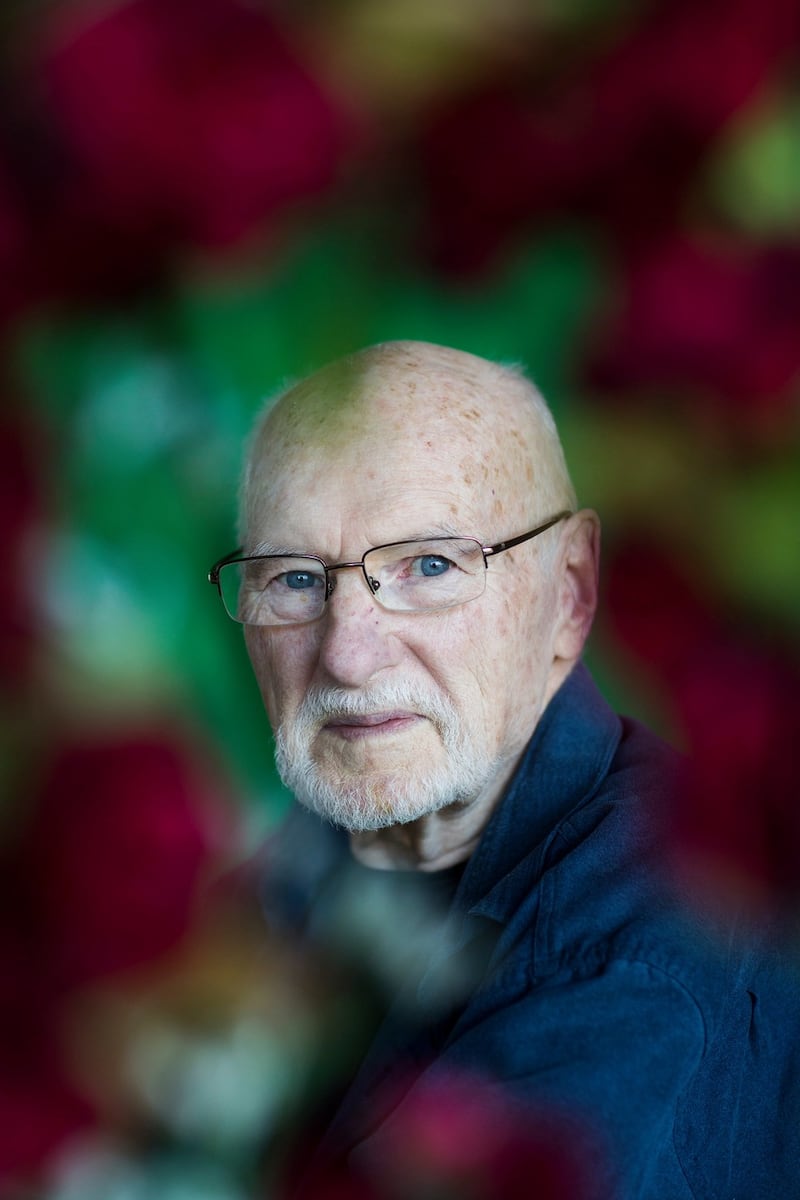
Happily, Green had become adept at brokering delicate family discussions over the past year. She had presided over 35 deaths since the law passed, each intimately different from the next. One man got dressed in his amateur clown costume, complete with wig and red nose, and died telling her jokes. He had insisted on being alone in the room with her, but most of her patients died surrounded by loved ones. Many were too sick to devise elaborate rituals, but others had chosen the location, attendees, readings and music as if planning a wedding. Green called them something she picked up at a conference on euthanasia in the Netherlands: “choreographed deaths.”
She arrived at Shields’ hospice room that day to finalize the plans. The couple held hands as she helped them stitch a compromise. On March 23, the last night of Shields’ life, they would host a party in the hospice solarium with Swiss Chalet takeout for all. The next morning, he would die in his hospice room. Then, his wife and stepdaughter would take his body home and lay it out in his beloved garden for two days.
The plan, Shields said that afternoon, was “absolutely terrific.”
One Man’s Cosmic Journey
A year and a half earlier, Shields was driving down a wooded provincial highway across the belly of Vancouver Island when he blacked out. His SUV crossed the centerline, plunged into a ditch and hit a tree. Hood, who had been sleeping in the back seat, was violently thrown. She snapped five ribs and ruptured her spleen. Shields broke his back in three places. When he came to, he thought he had been paralyzed. That he was not, and that they had not been killed or struck another car, seemed like a sign to Shields. Then there was this: An off-duty firefighter or police officer (they cannot remember which) happened to be driving behind them and summoned rescue workers, who arrived within minutes. Even their little cairn terrier, Diego, was rushed to emergency surgery.
Shields believed every person played a part in the continuing evolution of the universe. Clearly, he thought, he had more to do. But just a few months later, in fall 2015, a doctor summoned him to his office and broke the news. A biopsy of his heart, taken after the accident, revealed that Shields had a hereditary form of amyloidosis. The disease had caused his heart to stop temporarily (hence his blacking out behind the wheel) and was the source of the numbness and painful tingling in his fingers and feet that had plagued him for a couple of years.
The disease was unpredictable, but it would likely cause him to lose all feeling and basic use of his arms and legs before shutting down his heart, Shields recalled the doctor’s telling him. Shields had seen a friend die from a painful and disabling disease. He was terrified of facing a similar fate. “One quality of life that’s important to me is my dignity- and sparing anxiety for my wife and daughter,” he said. Becoming debilitated and being tube-fed was unacceptable to him. “All of those painful and demeaning things,” he said, “I considered beyond the threshold of how I would like to live.”
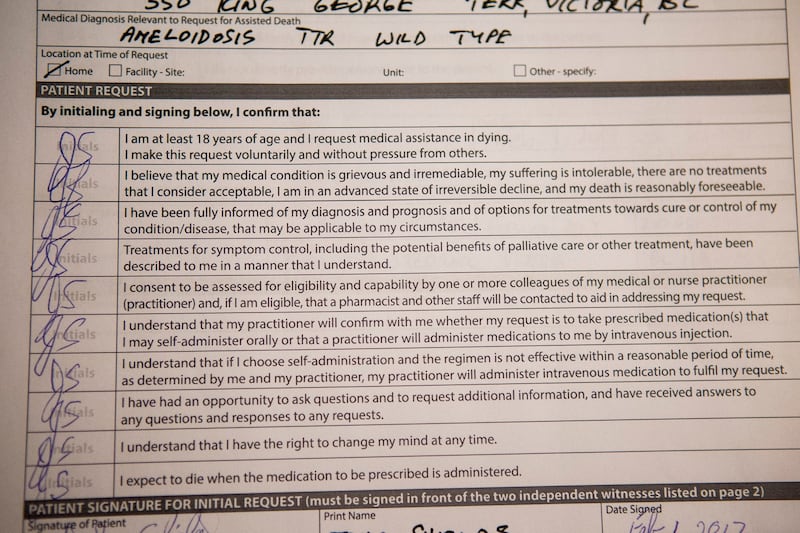
If service was the biggest theme of Shields’ life, the other was freedom - intellectual, spiritual, personal. He was always growing and exploring. In the last few months of his life, he tried a psychedelic drug for the first time and enrolled in an advanced online course on “transcending transpersonal realms.”
Shields was the rare combination of introspective extrovert. He could be seen wearing a silly hat made from a napkin one night and hosting a spiritual circle for men on another. He loved rituals, which began with the Catholic Masses of his childhood in New York City. He was the only child of a steamfitter and a teacher, both Irish and devout. Family lore had it that when Shields was a baby, his grandfather hoisted him up in one hand and proclaimed he would be America’s first pope.
At 17, he enrolled in seminary. By the time he was ordained years later, the Second Vatican Council had convened. Shaken at first by changes the council was recommending, Shields came to embrace them, especially the use of modern historical criticism in interpreting Scripture.
In his mind, this changed Christ’s message from one of sin’s redemption to pure love. But his was a minority view, and it set him on a radical path at odds with his bosses. He was transferred from his first parish, in Vancouver, and then barred from preaching and teaching at his second posting, in Austin, Texas, after he challenged the pope’s opposition to birth control.
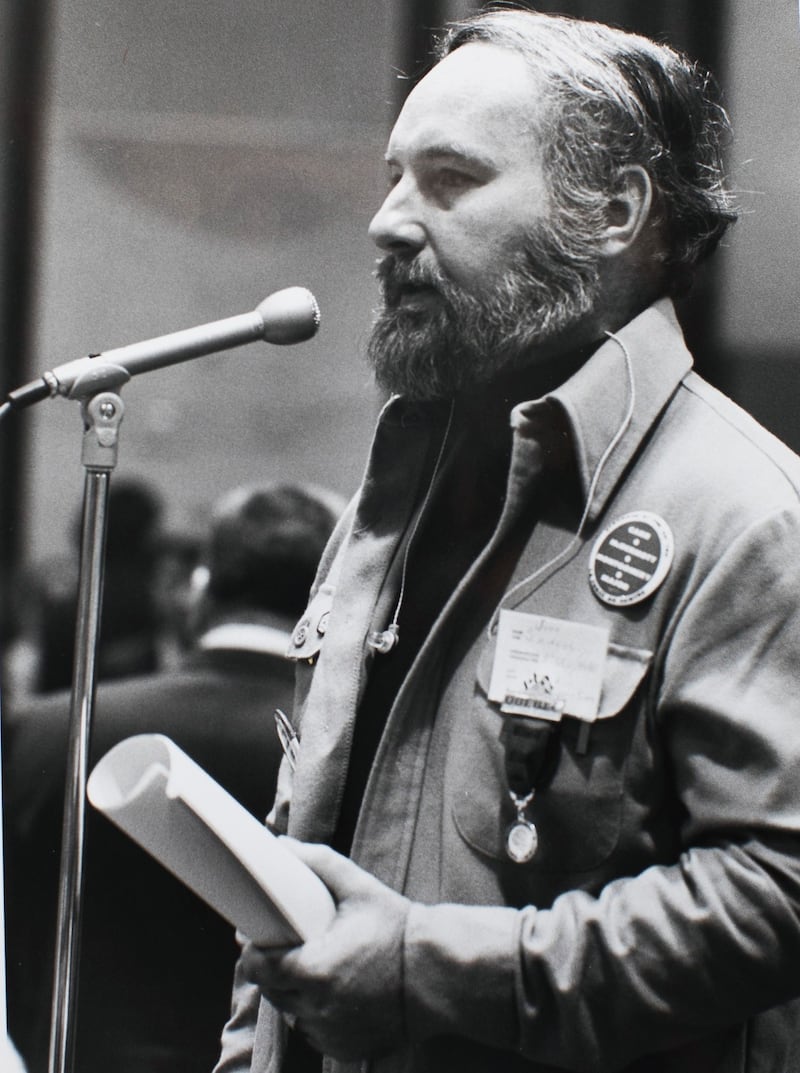
After only four years, he walked away from the priesthood, forlorn and distressed. The decision cost him not only his faith but also his purpose and livelihood. But from that difficult time emerged two loves. One was Madeleine Longo, who had worked with him in both places and who soon became his wife. The second was the wild and rugged landscapes of British Columbia, Vancouver’s province. In 1969, the couple moved here and Shields found a job as a social worker. His first clients were unwed pregnant women, many of whom wanted illegal abortions. He put aside any vestiges of Catholic doctrine after he heard their anguished stories. For Shields, nothing was black and white.
He eventually became a manager but was not satisfied treating problems at what he called the “discharge end of the social injustice pipe.” As a seminary student, he was active in the civil rights movement and had met the Rev. Martin Luther King Jr.
He wanted transformational change. Shields successfully ran for president of the British Columbia Government Employees’ Union, which over his 14-year tenure grew by more than 20,000 members to around 58,700. He was known as “the skipper” - a calm captain who was open-minded and unerringly ethical but also tough. He was most proud of securing equal pay for women in the union.
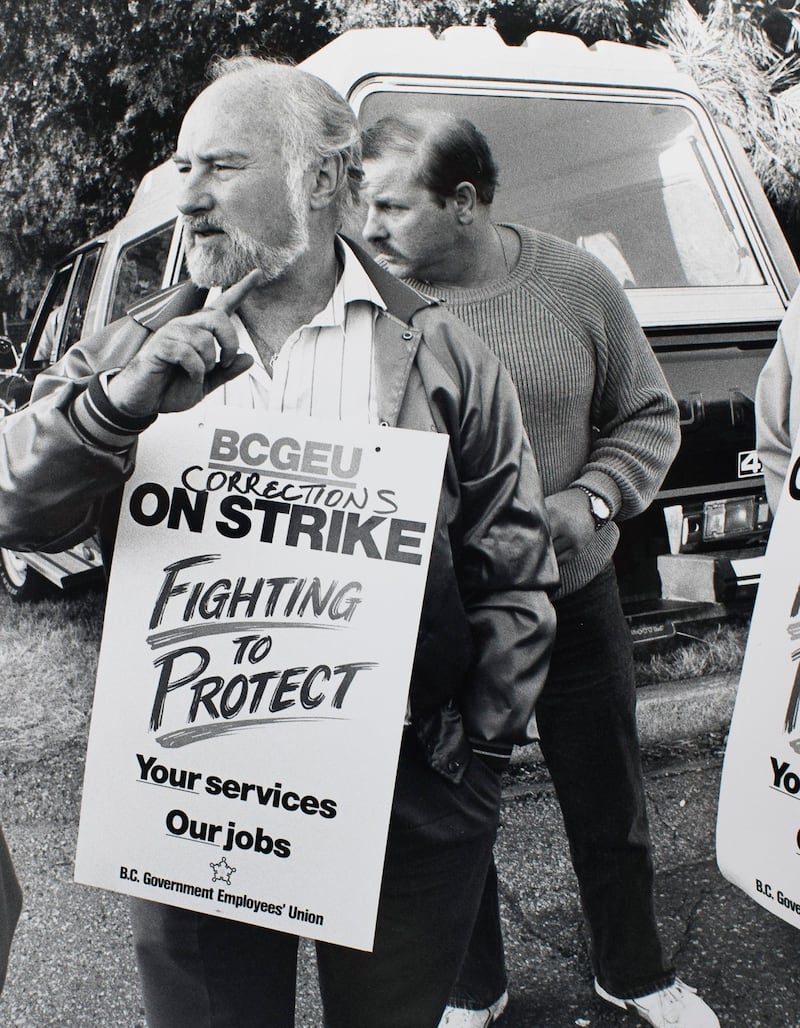
While his post-church professional life surged with purpose, Shields’ search for existential and spiritual answers was slow and meandering, often veering to the fringe. He studied Gestalt therapy and picked up dowsing, the art of divining energy with copper rods. Finally, a lecture by Brian Swimme, a professor at the California Institute of Integral Studies, changed Shields’ life. He became a spiritual cosmologist, believing that the universe was conscious and that everything was inextricably connected.
“We come out of the universe to play a role in the unfolding of the universe,” Shields wrote in his 2011 memoir, “The Priest Who Left His Religion in Pursuit of Cosmic Spirituality.”
“This perspective riveted me. This is the opposite of meaningless. I come forth at this precise moment to contribute my unique gifts to the great unfolding.”
In 1999, when Longo became ill with lymphoma, Shields decided to step down from his union post and care for her full time. He was still grieving from her death, in 2005, when he met Hood, an environmentalist with a doctorate in education who was 15 years his junior and had spent years working on human rights in Central America. She moved into his daffodil-colored stucco house, at the base of a cliff. It seemed more a cabin in a national park than a home in an old and genteel part of Victoria locally referred to as “behind the tweed curtain.” Deer grazed on bushes nearby and raccoons wandered liberally, enticed by the bowls of food and water set out by Shields. Orcas could be seen in the ocean, just a block away, and beyond that the white-capped peaks of Washington state’s Olympic Peninsula.
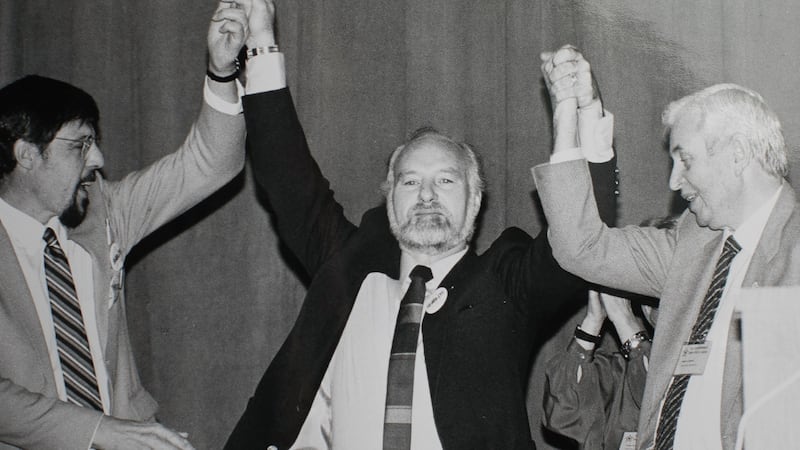
Hood’s then-19-year-old daughter, Nikki Sanchez, joined them and developed a close bond with Shields. Later, he would refer to her simply as his daughter and write that her love was “one of the most delicious gifts of a generous universe.” Hood warned him that marrying her also meant inheriting a tribe of female friends she called “the intertidals.” Over the years, many would wash up on their doorstep after a storm and move in for weekends or longer. One, an environmentalist and writer, Briony Penn, had persuaded Shields to come out of semiretirement and help steer The Land Conservancy, which was heavily in debt. He was driving home from a conservancy meeting the day he blacked out and crashed his car.
After the diagnosis, Shields retreated into his study and fell into the throes of grief. As someone who treasured independence, the concept of being trapped in his own body frightened him. He searched on the internet for what he called “life-ending cocktails.”
From Birth to Death: A Doctor’s Gift
Three walls of Green’s office are collaged with the faces of hundreds of smiling, angelic-looking newborns that she delivered over her 22-year career. Until three years ago, she specialized in maternity and newborn care with a side practice in circumcisions, which started not because of her Jewish upbringing but because few local doctors were willing to perform them. To her, it was a matter of principle. “It’s about choice - the same as MAID,” said Green, a 48-year-old mother of two, referring to the medical assistance in dying law. “Give people good information and let them do what they think is best for their family.”
Green gives off the aura of a university volleyball team captain - warm, competent, no frills, no makeup, nothing hidden. Last year, she took bridge lessons with a group of octogenarians at the local seniors’ center and now plays weekly. For family reasons, she took time off and decided she needed a better life-work balance than the erratic schedule of delivering babies allowed. A month before the new law came into effect, she traveled to the Netherlands for a conference on euthanasia.
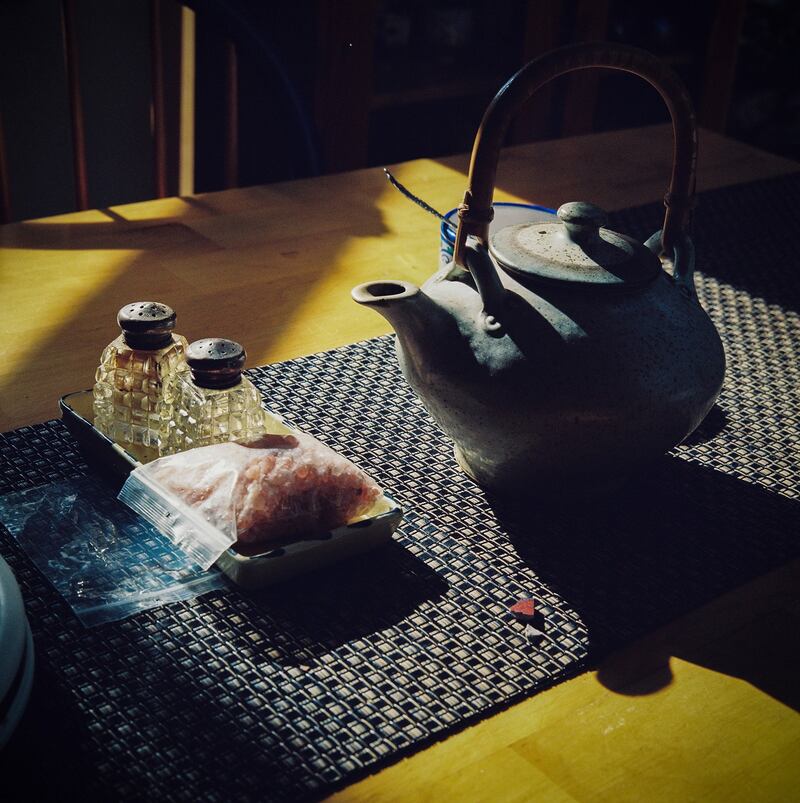
“Birth and death, deliveries in and out - I find it very transferable,” she explained one morning as she walked her small white poodle, Benji, on a beach near her home. “Both are really intense and really important.” Many of her colleagues on Vancouver Island agree. Off the west coast of Canada, Vancouver Island has been ground zero for assisted suicide in the country. It was here that Sue Rodriguez, a 42-year-old suffering from amyotrophic lateral sclerosis, or ALS, began her battle to die with dignity in the 1990s, going all the way to the Supreme Court. “If I cannot give consent to my own death, whose body is this? Who owns my life?” she famously said.
The court ruled against her in 1993, saying that the state’s interest was protecting life’s sanctity. Less than five months later, Rodriguez died in the company of a friend, from what police called a “doctor-assisted suicide” ? although they never pressed charges. Seventeen years later, other patients and lawyers in British Columbia picked up Rodriguez’s case. This time, the Supreme Court struck down the criminal sanctions against medical professionals who assist in suicide and perform euthanasia in prescribed circumstances.
Under the new regulations passed by the government, participants must be adults who are in an advanced state of a “grievous and irremediable medical condition.” Their suffering must be intolerable and their natural death “reasonably foreseeable”, meaning people with long-term disabilities are not eligible unless they are near death. Patients must also be deemed mentally capable of consenting to the procedure moments before it happens. This stipulation is among the most debated parts of the law since it automatically bars people with dementia, even if they give advance consent.
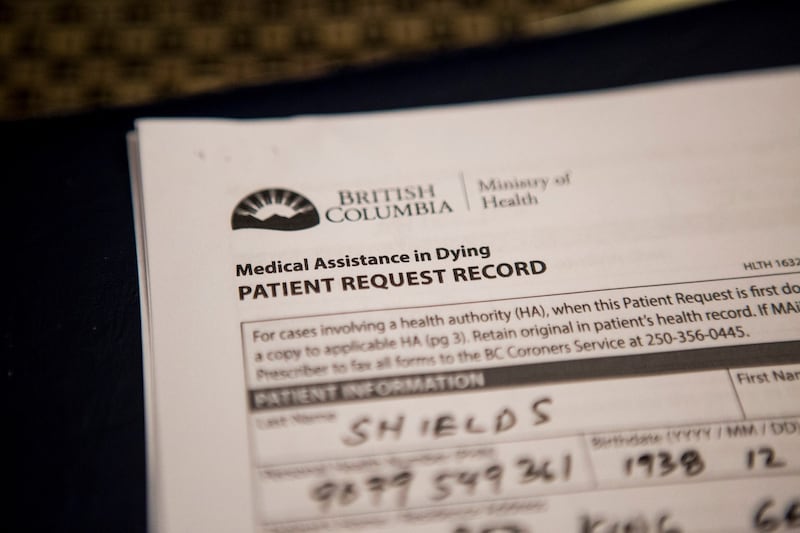
Unlike in American states where similar laws exist, the Canadian system puts doctors and nurse practitioners at its center. They must not only determine whether a patient is eligible but also oversee administration of the lethal medication. Doctors are not legally bound to participate but in most provinces are expected to refer patients to colleagues who do.
Many doctors have refused to take part, believing that the law goes against their Hippocratic oath. Christian doctors in Ontario are taking their professional college to court, arguing that the requirement to directly refer patients infringes on their religious freedoms. On the other side, the lawyers who won the Supreme Court case have filed suit on behalf of people suffering intolerably from illnesses that are not terminal. They think the law should be expanded.
The public backlash many doctors feared against the law never materialized. Still, most doctors across Canada who have chosen to participate have done so quietly, even asking patients to withhold their names from their obituaries. The exception has been on Vancouver Island, where Green and many of her colleagues advertise the service and publish their email addresses and phone numbers online. They have formed a national organization on medically assisted suicide and are holding their first conference in June.
And residents here have embraced it like nowhere else. With a population of just 771,000, Vancouver Island is the country’s retirement community as well as a hotbed for alternative lifestyles. Of the 803 people across the country who chose medical deaths in the first six months since the law passed, 80 of them were from here.
Green and her colleagues have witnessed how the law is changing not only the method of dying but also the rituals around it. Many patients are planning goodbye parties, requesting special last meals and choosing to die at home. “You don’t judge a civilization by its riches but by how it treats its vulnerable,” Green said. “I think this is a mark of our humanity.” She’s never understood doctors who say offering lethal medicine goes against their training. “I think people go into medicine because they want to help people,” she said. “This is on the continuum of care of helping people.” She and other doctors said that most of their patients suffer more from psychological than physical pain. Just being approved for a medical death can be therapeutic. For some, the knowledge that they can control their exit translates into more peaceful final days.
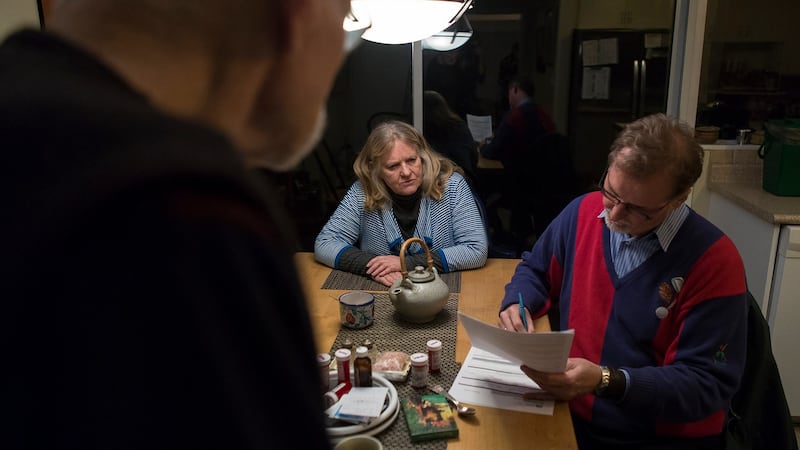
The first death Green oversaw remains her touchstone. The man was dying from liver failure and his family opened their home for friends and neighbors to drop in and say goodbye. When he died, they all held him, including Green. “It was a beautiful event,” she said. “It felt really like we were giving him a gift. It felt so good.” In October, Green participated in a panel discussion about medical deaths in the little public recreation center near Shields’ home. Sitting in the audience that day was Hood.
‘I Don’t Want to Suffer Anymore’
By the time Green paid her first house call to the couple’s home three months later, Shields’ neuropathy had progressed so much that his feet were permanently numb and covered in sores. He wore leather gloves on his hands, which had also lost all feeling. His skin was distressingly itchy. He could no longer swallow dry food. He vomited regularly.
When he noticed his wife and daughter were shielding their torment about his declining health, he asked them to start a new tradition. Every Wednesday, they would light the dining room candles, put out the nicest hand-thrown pottery and silverware, and share their grief, anxiety and anger with him. They also began to discuss the plans for his death. The result, he said, was that they felt closer.
“What could be more meaningful than planning for the end of your life?” he said. He focused his energy on a workshop his wife helped facilitate called “Living Well, Dying Well,” speaking openly about his pending death and making new, intimate friends. While many people approaching death become increasingly insular, Shields continued to expand his world.
Still, he had not set a death date. He expected to live through spring and hoped to see summer blossoms emerge in his garden. One night in February, less than two weeks after he was approved for assisted dying, Shields awoke in his favorite maroon chair in the living room in a delirious state. He had fallen asleep reading and missed a round of medication. “He didn’t make any sense,” Hood said. “He was totally incoherent.” A nurse from the Victoria Hospice was dispatched to the house in the middle of the night. She thought he had an infection and put an intravenous catheter into his arm so his wife could administer medications. In the morning, it took three women - his wife, his stepdaughter and a friend - an hour to guide him a dozen paces to the washroom. One lifted each foot with her hands. They realized that he had been in much more pain than he let on and that they could no longer care for him at home.
Later that morning, he was settled into a room in Victoria’s only hospice, an art deco, cotton-candy pink building on the edge of a hospital. It opened in 1946 as a maternity ward and retains that ambience. His family carted in pots of daffodils to scatter around his room, along with some of his favorite books and CDs. They loaded up the bar fridge with food and settled into the brown sofa chairs in the corner to wait and worry. A testament to Shields’ wide legacy: a nurse on the floor had been one of his foster care cases from his time as a social worker, and a counselor at the hospice was one of his oldest friends who had worked with him back in 1971. Three days later, Green came to check in on Shields and tell him she was going on vacation with her husband. That put the family in a difficult position. If Shields wanted to proceed with his death, he had two options: schedule it for the very next day or in two weeks, on March 24.
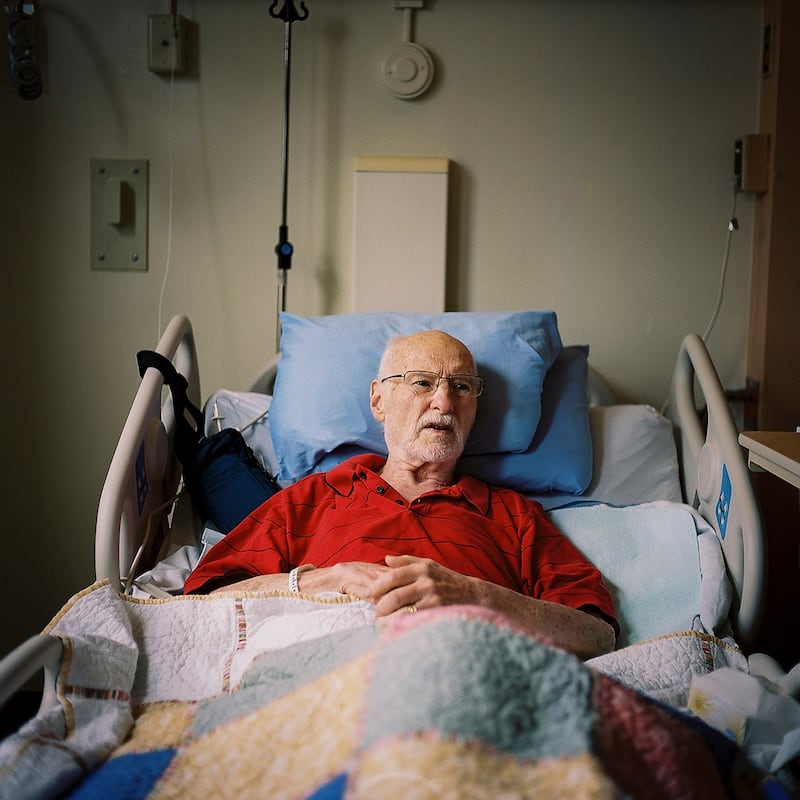
“Can you imagine?” said Hood, sitting on a couch in the hospice’s comfortable lounge. A half-finished puzzle had been left on a nearby table and a guitar hung on the wall for general use. Tears filled her blue eyes. “Your partner all of a sudden is going to die the next day. It’s bad enough he’s going to die in a few weeks. But tomorrow? That was too much.”
The scheduling was not the only agonizing part of the decision. She also worried about Shields’ mental capacity. He was not thinking clearly. That morning, he asked her if she had brought his sleeping bag. He was going on a voyage, he said. She was not sure if his confusion stemmed from the disease’s progression or the cocktail of pain medication hospice doctors had put him on. Either way, she worried that his lucidity would slip further and that Green would not be able to perform the procedure.
“John is right smack in the middle of the issue he was worried about - his ability to give consent,” Hood said. This is the fine edge patients must balance, stretching out the last moments of their lives before the option to control their deaths disappears. It is a bit like playing chicken. Green has had to disqualify a number of patients who could no longer understand the gravity of the decision before them. “It feels like there should be flexibility in the law, but right now there isn’t,” Green said. “Sometimes, it feels cruel.”
Over the next few days, Shields’ pain got worse and worse. None of the usual treatments worked. For the first time in their decade-long marriage, his wife saw him cry. He became weaker. He lost weight. And his mind continued to be murky. He could express his thoughts for a few sentences, then lose them in a rush of words.
The hospice’s expertise was end-stage cancer, not amyloidosis. Shields’ case was the first its medical chief of staff had seen in his 20 years of palliative care. Two weeks after Shields was admitted, doctors tried lidocaine - a powerful local anesthetic commonly used by dentists. For the first time in months, Shields slept through the night. His thoughts became noticeably clearer. Once impossibly and improbably far away, March 24 barreled down like a speeding train. Family and friends who visited him at the hospice felt conflicted. They knew this was what he wanted but it broke their hearts, particularly now that he seemed more like himself. One moment, his niece wanted to rip off the remaining time like a Band-Aid; the next, she longed to linger inside each precious second.
“This should be easier on me because it’s predictable. But it isn’t,” said Donna Morton, who had lived in the family’s spare bedroom for more than a year and considered Shields her spiritual father. “I feel a little panicky.” Buoyed by his improvement, his wife hoped he might push off the date. But he did not want to. “No matter how I looked at it, I saw pain,” he said. “No matter how I looked at my life from this moment on, I see personal, physical unbearable suffering. I don’t want to suffer anymore.”
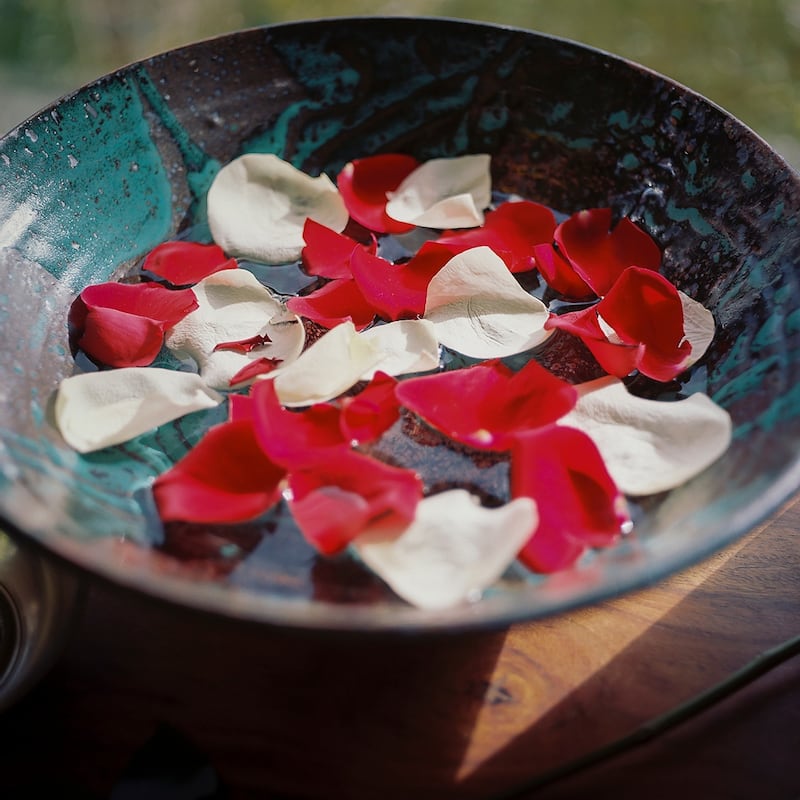
He also felt like a pioneer. Recently, he dreamed that he was sweeping up large shards of glass from a hallway, making it safe for others who would pass that way after him. The idea for a final party with fixings from Swiss Chalet came to him because of the extraordinary kindness he had received at the hospice ? from friends and strangers alike. That morning, a hospice volunteer gave him a pastel-colored homemade quilt, which was now covering his lap. He wanted to spread some of that “loving energy” around.
“Besides,” he said, “I like chicken.” Hood felt like escaping to the woods to cry. It was her husband’s last night, and he wanted to have a party with food from a restaurant they had never eaten at together. But this was one last token of love she could give him. Putting aside her anxiety and sorrow, she sent out an email invitation to select friends.
It was titled “John’s Farewell Party.”
Saying Goodbye. But First, Chicken
On March 23rd at 6pm, a heavy atmosphere hung over the small hospice room aspirationally called a solarium. No one knew what to expect from a living wake, not even Penny Allport, the life-cycle celebrant Shields had asked to help guide the party and preside over his death the next morning. She was trained and certified for funerals and weddings, but nothing like this.
Efforts had been made to convert what normally felt like a doctor’s waiting room into a place worthy of the occasion. A pale green hospice blanket served as a tablecloth over two adjacent coffee tables, which were decorated with a vase of simple daisies and daffodils and strewn with cue cards, each of which bore one of Shields’ favorite quotations in colored ink.
“Tell me, what is it you plan to do with your one wild and precious life?” - Mary Oliver
“There is nothing more mysterious than destiny - of a person, of our species, of our planet, or of the universe itself.” - Brian Swimme
A small electronic keyboard was tucked into a corner and repurposed as a bar. On one end were bottles of a local Shiraz with “Rebellion: On Your Own Terms” on the label. On the other was a chocolate hazelnut cake Shields had requested. It came from a virtuous bakery, even by Victoria’s hippie standards - grain bought locally and ground in-house. The foil to Swiss Chalet, it captured the opposite extremes of Shields’ personality.
People milled about in a nearby kitchen area, taming their grief and nerves by pouring out bowls of nuts and chopping apples. More arrived, bearing instruments and flowers. At 6.12pm, two nurses wearing blue latex gloves wheeled Shields into the solarium and plugged his medication pump into a wall socket. He was sitting up in his giant humming airbed, a royal purple shawl hanging around his neck like a towel after a tennis game.
It was as if a switch had been flipped. With his appearance, the room’s heaviness lifted. “You think I’m only going to have one portion?” Shields said when presented with his plate of Swiss Chalet chicken. Laughter erupted around him. His stepdaughter, Sanchez, pulled his favorite black-brimmed skipper’s hat down over his brow. Once he finished his meal, Allport began the farewell ceremony. Tall with long, wavy brown hair streaked with gray, she had the posture of a yoga instructor, which she had been for years. Standing behind him, she held up a white khata - a Buddhist prayer scarf - and instructed each guest to place a verbal blessing in it for Shields. She called his death his “great blooming.”

“My name is Penny,” she said, pressing the scarf to her chest. “I offer the blessing of courageous heart.” The scarf was passed to Hood, who held her husband’s hand and looked into his eyes as she spoke. “My name is Robin,” she said, her soft voice catching in emotion. “I bring the blessing of community, of justice, of peace and of having been the partner of a wise and beautiful loving man.” The room was filled to capacity. Two dozen people hovered over Shields, pressing themselves against the walls and folding their bodies onto the floor. Others bunched by the door.
One after another, proclamations of love, admiration and gratitude poured forth. They thanked their host for opening his door when they were brokenhearted. They thanked him for his friendship. They thanked him for his courage. “I thank you for the gift you are giving us tonight,” said Heather Fox, the grief counselor he met in 1971. Time and again, Shields acknowledged and thanked each speaker and doled out some tailor-made insight or joke to lighten the mood. When a former colleague planted a goodbye kiss on his lips, he unleashed more laughter with the quip: “I was just thinking, ‘I’d like to see more of that.’ Then I thought, ‘That’s not a good idea.’”
Hood saw the priest her husband once was, offering blessings and benedictions to his congregation. Union friends remembered his speaking before giant crowds at rallies in the 1980s. “He has never met an audience he didn’t love,” said Preben Skovgaard, his former chief of staff and best friend.
Skovgaard found the public weight of the moment too much and escaped to the hall for most of the evening. When he was finally yanked by one arm into the room, he offered a loving roast. “You’ve talked a lot about some of John’s abilities,” he said. “I want to talk about one more. And that is, he has an innate ability to piss you off.”
This was an Irish wake, without grief’s frantic edge. Shields was still here, sipping his final glass of American beer. Many looked over at him with wonder, understanding that he was offering them one final lesson. As the party wound down, Fox handed out the lyrics to the Celtic folk song “The Parting Glass.” They serenaded him.
But since it falls, unto my lot,
That I should rise and you should not,
I’ll gently rise and I’ll softly call,
Good night and joy be with you all.
Shields was waning. He had already tried to make a speech, but his mind wandered off script. This time, he hoped to get through what he called the “verses of a special departure song.” He closed his eyes. Eighteen seconds passed, until it seemed perhaps he had drifted off to sleep.
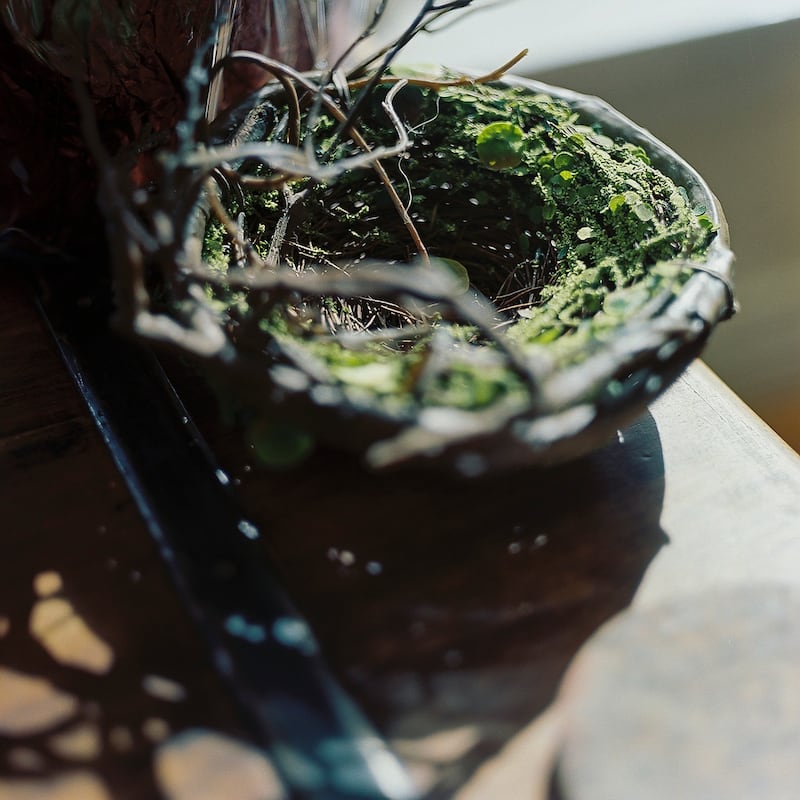
“When we blossom forth into the night,” he said finally, his eyes still closed, “what do we hear? We hear the silence of the bees. We hear the brushing of the wind in the trees. We hear the whisper of wind to branch and branch to wind. And we know that we are close to the end of the journey.”
He opened his eyes. “And to all of us, who have come together. You are seeing me get sad. It would never happen without some sadness. He thanked his friends, one more time. When they came to their death and they heard the song of the bees, he hoped they were as happy as him. “I’m welcoming you all to sing it with joy,” he said. At 7:40, the nurses arrived and unplugged his medication pump. Shields waved to his friends as his bed was wheeled out of the solarium. “I will see you later,” he said, smiling.
‘Who Could Ask for Anything More?’
The morning of Shields’ death, Green took her dog for a walk on the beach before driving to the hospital pharmacy to pick up the drugs for the procedure. Patients have two options: they can drink a cocktail of lethal medication, or they can have the doctor administer drugs intravenously. Like nearly everyone, Shields chose the second. The pharmacist had already prepared the doses for Green. There were four drugs, drawn up into syringes. First, an anti-anxiety medication called midazolam that puts most people to sleep quickly. Then a small amount of lidocaine to numb the vein, followed by a large dose of propofol - the anesthetic often used to ease people to sleep before operations. The thick, white fluid filled two fat syringes the diameter of quarters. Green always warned family and friends about the ominous size of those needles before she started the procedure, so they were not frightened.
The propofol would put Shields into a coma. The final drug she would inject into his IV catheter was a paralyzer called rocuronium. It stops all movement. Green would administer doses of saline after all but one of these drugs, to make sure they had completely entered Shields’ system. The pharmacist gave Green a second dosage of everything, in case she needed to restart the protocol. That has happened to her only once. It involved a younger patient, whose heart took 19 minutes to stop - nine long minutes longer than average. Since then, Green has set a limit. If a patient’s heart does not stop 15 minutes after she administers the propofol, she starts the entire procedure again, just to be sure.
The pharmacist packed the medication into two blue boxes, like the ones construction workers use to carry their lunches. Green took one in each hand. Another doctor on Vancouver Island admits she has trouble sleeping the night before a procedure. One other has her partner drive her home afterward as she is so emotionally drained. Green has neither of those problems. She was well rested and happy heading to the hospice that morning. If she felt jittery, it was only because she was double- and triple-checking the procedure in her mind and making sure she was ready. She took the elevator to the third floor and walked down the hospice’s beige hall to Shields’ room. They talked intimately for a few minutes. She asked him if he still wanted to go ahead. He did. She was convinced that he was of sound enough mind to make this decision. He signed the last page of official paperwork, confirming that he had been given the chance to change his mind and that he still wanted to go through with this. Green instructed a nurse to set up his intravenous line while she slipped down the hall to go over the procedure with his friends and family. She assured them that his death would be peaceful. He would simply go into a deep sleep and might even snore. But, if at any time it got too hard, they should leave the room. “There are no medals for staying,” she said. “There’s no judgment for leaving.”
Shields had asked five people to be there: his wife, his stepdaughter, Skovgaard, Fox and Allport, who was overseeing his death ceremony. When they entered his room, Shields greeted them with a smile. His blue eyes twinkled, matching a fresh aqua T-shirt. The quilt of unexpected kindness was spread over his legs.
The room was dark and cool. The overhead lights were off and one of the windows was open. Across its sill, an altar had been fashioned with cedar boughs, smooth stones, eagle feathers, a small red candle and a tiny bell. The emerald moss coating the limbs of a giant Garry oak tree outside glowed into the room.

Since Shields could not die in his garden, his garden had been brought to him. A large white candle flickered on the night stand beside him. The hospital tray that had held his meals for the past two weeks was pushed to the side. Upon it was one of Green’s blue boxes, and eight syringes lined up neatly in a row. The group formed a circle around Shields, with his wife at his head, touching his shoulder. He asked her what was happening, and she recounted what Green had said about the procedure, adding that he should go toward the light. “Sounds perfect,” he said, giving a thumbs up. It didn’t sound so perfect to her, she replied. It was as good as it was going to get, he said.
Allport began the ceremony she had designed with input from Shields and inspirations from a mix of cultural traditions. She opened her arms wide, turned to each direction of the room and related it to Shields’ life. The east was the wind on which his beloved eagles fly. The south was fire and the snake shedding its skin, as he soon would. The west was water, filled with whales that passed his house. The north was the trees, like the thousands he had protected.
She had taken the bell from the windowsill and rang it between each turn, its tone bouncing lightly from the walls. She called up to the sky and the heavens, and crouched down on the floor, thanking the earth for carrying his body for 78 years. When she finished, she paused. There was not a sound in the room. Shields, she said, would need ancestors to help guide his journey. They needed to be summoned. She asked everyone to mimic a movement she noticed Shields making recently: two hands placed on the heart and then swung open like saloon doors. If the names of ancestors came to their minds, they should call them out.
Hood whispered the names of his father, mother and former wife, Madeleine. Shields opened his eyes and quietly said Rumi, the 13th-century Persian poet. Sanchez held his right hand in hers, sobbing. Her nails were painted metal green, accentuating how pale his numb fingers had become. One of his regrets was that he could no longer feel a touch like this. His wife leaned over and told him his love had been radiant. When she finished, he said, “Thank you, my darling.” Shields then began singing a refrain from an old Gershwin Broadway tune: “Who could ask for anything more?” The others joined in. “I got daisies, in green pastures. I’ve got my man. Who could ask for anything more?”
The singing came like intermission during a heartbreaking movie. Shields was delighting in life, right to the end. The ritual held the moment’s solemn structure; he was adding some human lightness. He did not seem afraid. The day before, when Allport asked him if there was a poem he would like read, he asked for a Catholic one: the Prayer of St. Francis of Assisi. Standing at his feet, Fox unfolded a copy. “Lord, make me an instrument of thy peace,” she began. Shields mouthed the words silently. He had left Catholicism almost five decades before, but Catholicism had not entirely left him. It was as if all the disparate strands of his life were being woven into this final moment.
Where there is hatred, let me sow love;
Where there is injury, pardon;
Where there is doubt, faith;
Where there is despair, hope.
“I think I’ve learned that lesson,” he said, when she finished. For all of his openness and shared emotions, Shields was a stoic man. But when his wife told him that fires were burning for him on different islands, and that native elders were playing drums for him farther north on Vancouver Island, he closed his eyes and wept.
He talked about his father and his mother. In his life, he said, he had come to believe that everyone shared the same cosmic energy. “We are all one,” he said. He thanked everyone for their kindness. The sound of cars passing in the street below echoed up faintly through the window. Hands touched shoulders and hands. Green leaned over and quietly asked him if he was ready. By then, Allport had laid the white khata from the night before across Shields’ neck. His eyes were closed. He opened them and slowly scanned the faces around him, taking in each one. “Are we ready, friends?” he asked. He turned his head to look at the doctor. “Yes, Stefanie,” he said. “I am ready.”
Green took the first syringe from the table and screwed its tip into the IV catheter on the tender side of Shields’ left arm, then pressed its plunger down. He closed his eyes. His face relaxed. He appeared to go into a deep sleep. The only sound in the room was his stepdaughter’s crying. One after the other, Green went through the syringes until none were left on the table. Shields’ body remained still. He made no grimaces. The only change was a slight yellowing of his face. Green pulled her stethoscope from around her neck and listened to his heart. It was still beating. A few minutes later, she did it again. And then, a third time. Finally, 13 minutes after she had administered the first medication, she nodded to Hood. Shields was gone.
Going Home to His Garden
That evening, Shields’ body lay on a stretcher in his backyard. A large purple sheet was draped over his face and body, followed by a thick brown blanket as though he had been tucked into bed. His favorite black hat with the skipper’s brim had been pulled over his concealed brow, and a thin book of poetry slipped beneath his pillow: “The Subject Tonight Is Love” by Hafiz, a 14th-century Persian. A beige canvas shelter protected him from the sprinkling rain. Boughs of cedar, white currant and flowering plum hung in bouquets from its corners, and its lip was decorated with prayer flags. A candle flickered on a nearby table. Friends sat in chairs that were placed around him. For Hood, the best part of this new way of dying in Canada was also the worst part. The scheduling tormented her and organized her. While her husband was intentional about his death, she was intentional about his final rites. They would be administered at home, by his loved ones, and not by the funeral industry.
She believed that her husband’s spirit would stay with his body for two days before journeying on. So someone was always in the garden with him, reading poetry, recounting stories or just sitting silently, keeping him company until he was taken to the crematory.
Neighbors dropped off food, wine and cords of wood for the fire, which burned continuously. At night, Shields’ friends stood around it and serenaded his still body and memory. It was spiritual and poignant, ritualistic and community-based. “He would have loved it,” his wife said. Those two days, the weather was fickle - the rain gave way to sun, the wind to calm, and then it rained again. Flocks of birds arrived. Deer and raccoons visited. The majestic Douglas firs swayed above Shields. His garden was wild and beautiful, just as he had loved it.
New York Times
















